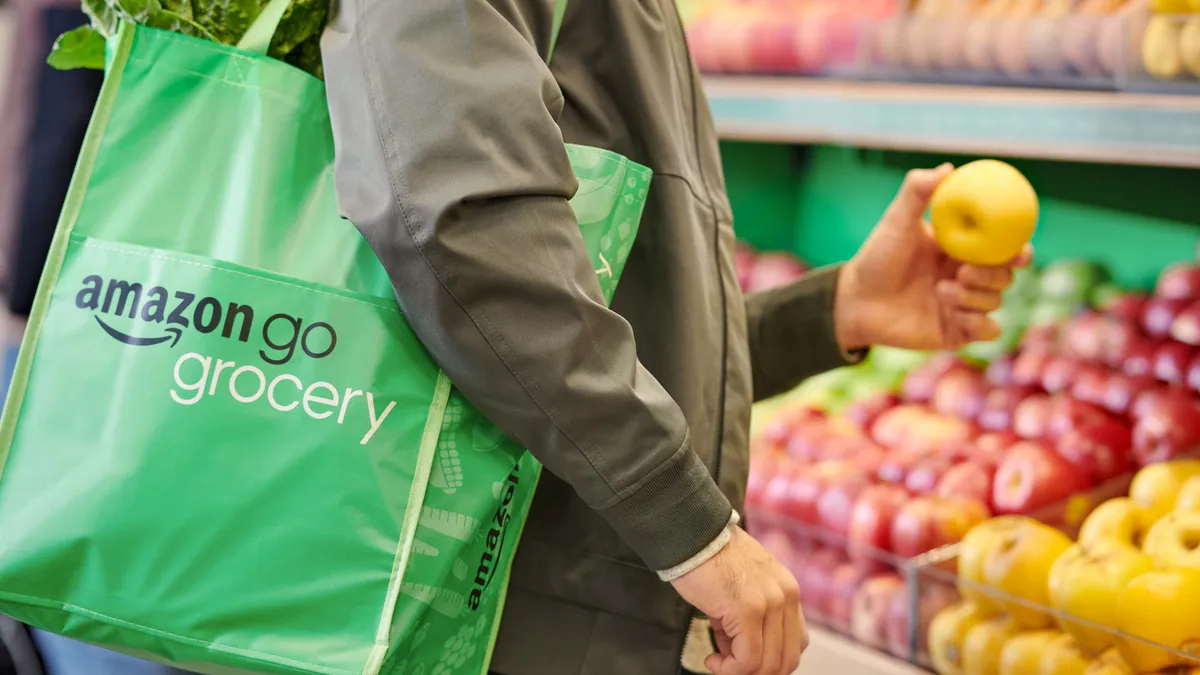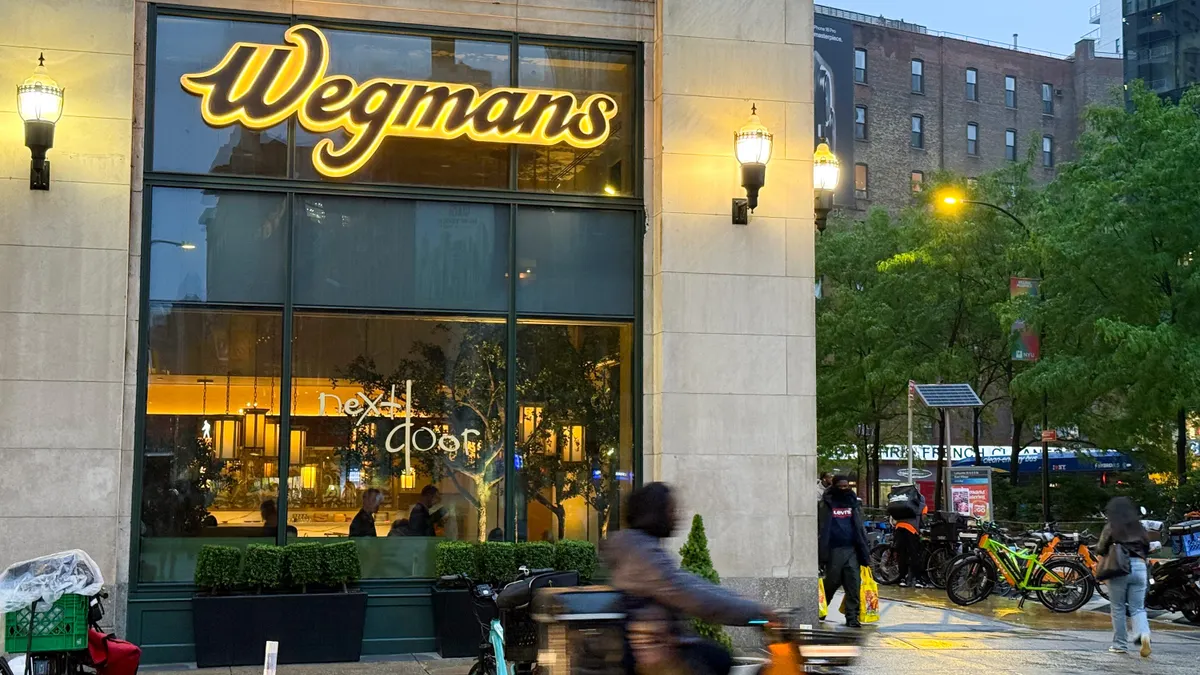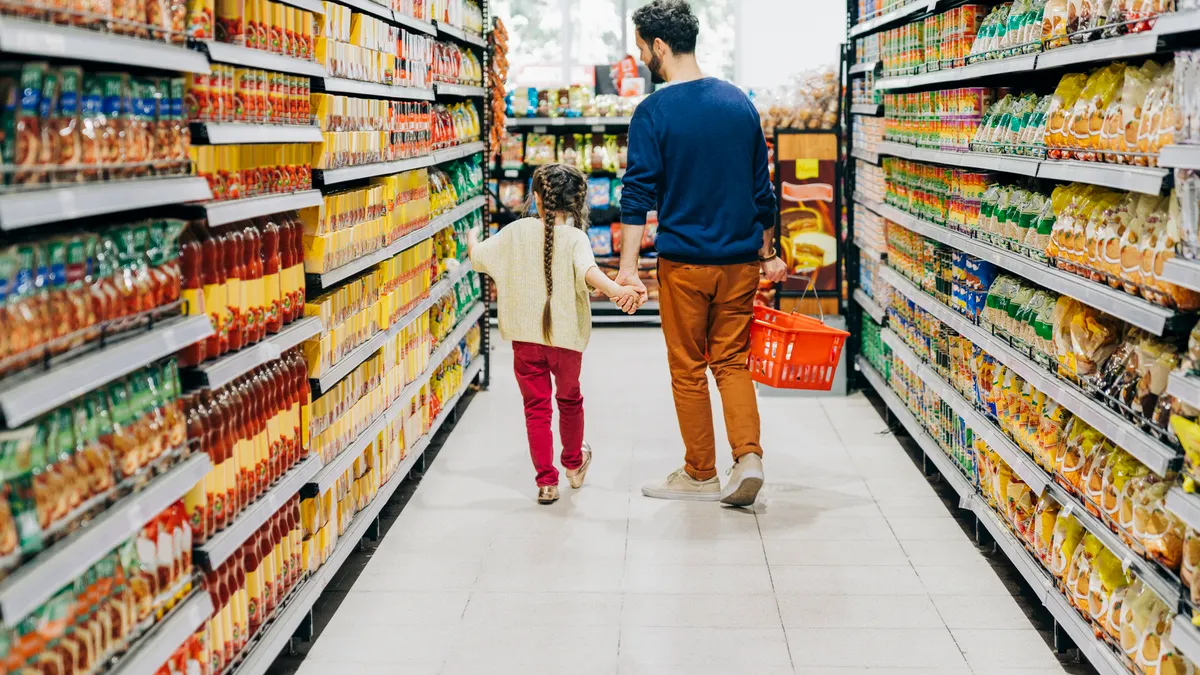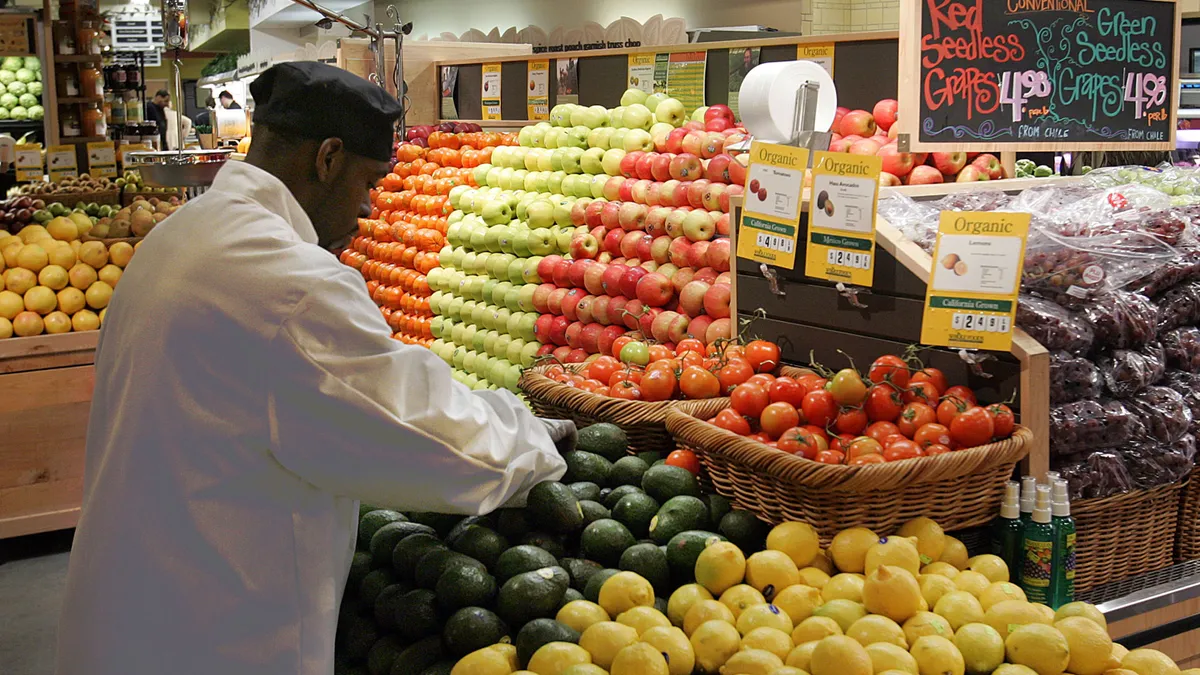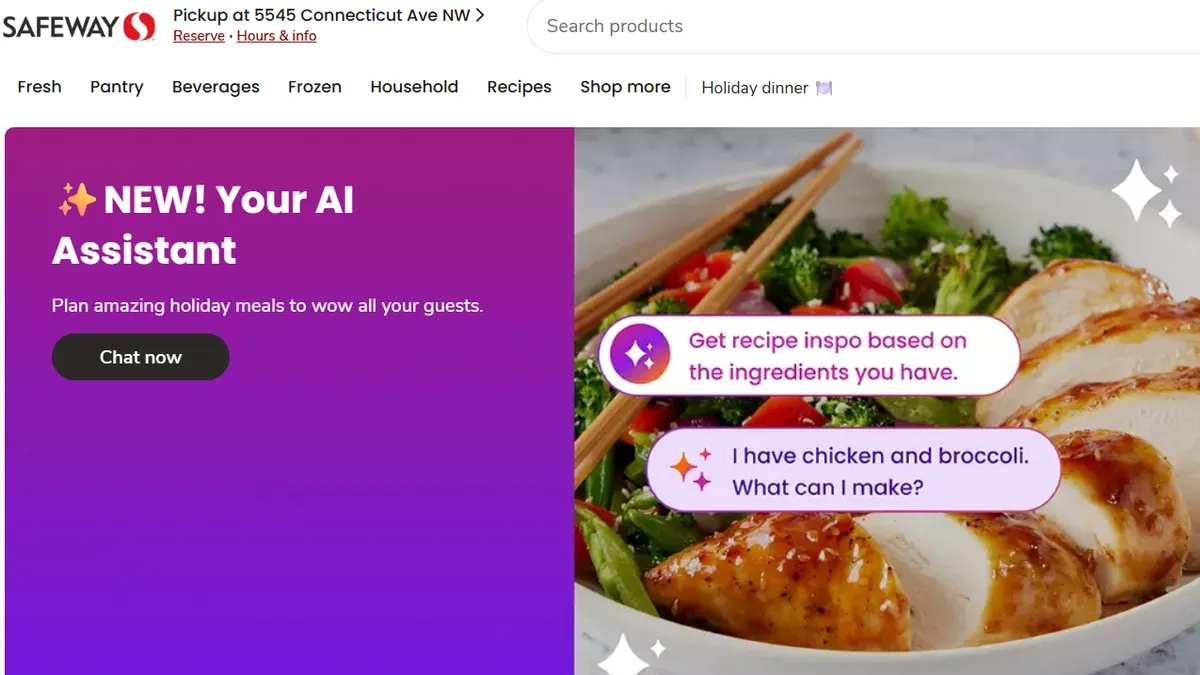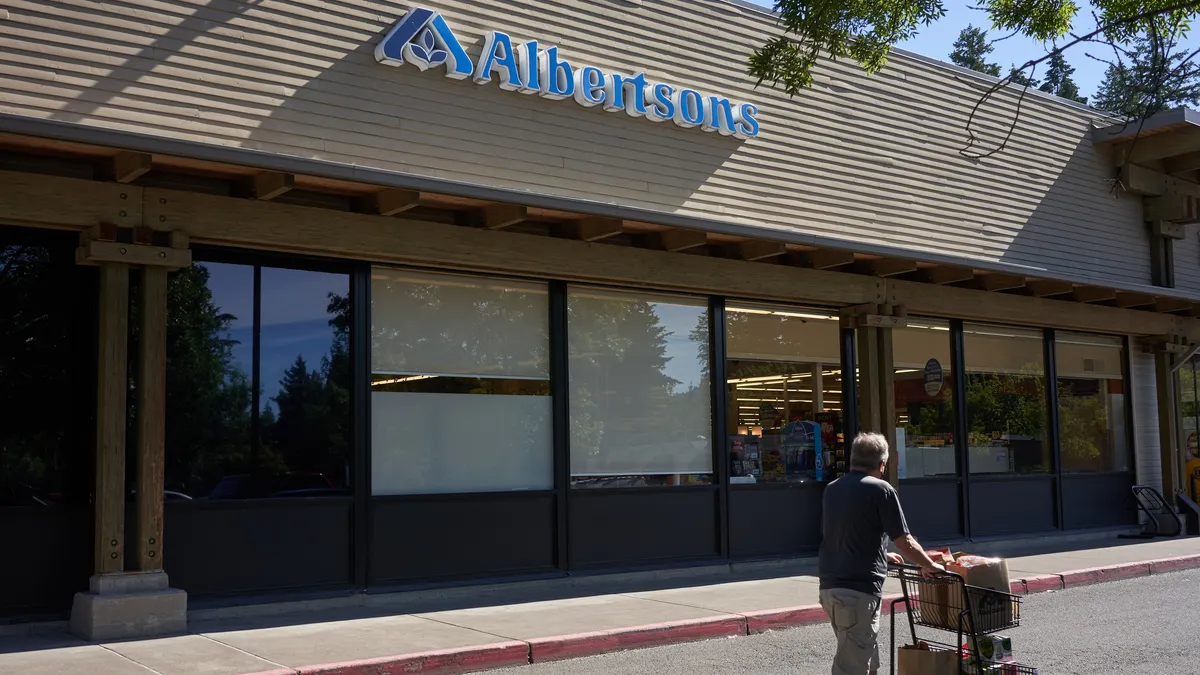Experts agree that Amazon Go Grocery is impressive — a technological marvel able to efficiently crunch massive quantities of data as shoppers pick out fresh fruit, snag doughnuts and fresh meals, pour their own coffee and bag everything up before simply walking out of the store.
But sources interviewed by Grocery Dive say they’re not ready to herald the company’s first cashierless grocery store as a guaranteed industry disruptor in the same way many were when Amazon bought Whole Foods, or when the e-tailer first announced the Go model.
And they’re circumspect about the company’s ability to license the Go technology to other retailers and businesses, a strategy reported by The Wall Street Journal and other outlets.
Despite the quick and novel shopping experience, not to mention all the sophisticated technology humming along in the background, the store, which opened Tuesday in Seattle's Capitol Hill neighborhood, seems to be lacking elements that would make it a consistent shopping destination, sources said.
David Bishop, partner with consulting firm Brick Meets Click, said Amazon Go Grocery looks very “sterile” and has some puzzling elements to it. He pointed to a small bagging counter inside the store that’s put forward as a helpful space where customers can reorganize their items, but that could only accommodate one customer and a small number of products at a time, he said.
Requiring shoppers to bag their own groceries — a process that can be tricky given the assembly of boxed, chilled and breakable items often left to store baggers and cashiers — could negate the frictionless experience on the back end for many. Chris Walton, a former Target executive and founder of Red Archer Retail, said the process seems to discourage large shopping trips.
“What is the operational procedure for bagging and exiting the store with a large number of items?" he told Grocery Dive. "That has not been solved, and that’s going to take experimentation.”
Brian Walker, a former Amazon manager and currently chief strategy officer with digital experience firm Bloomreach, said he’s not convinced Go Grocery is solving a real problem for consumers. The original Amazon Go concept, as a walk-in-walk-out meal destination, makes more sense than a grocery format, he said, where customer service and human interaction are core to the experience.
“I think this is less about disrupting the customer experience and more about cost,” Walker said, noting labor costs specifically. “I think this is being packaged as being about customer convenience innovation.”
The bigger question, Bishop said, is whether shoppers will still see value in Amazon Go Grocery after the novelty of frictionless shopping has worn off. Amazon, he said, is great at developing and incorporating new technology, but hasn’t yet proved its mettle as a brick-and-mortar merchandiser. He gave the company a “C” grade for its efforts so far with Whole Foods, Amazon Books, 4-Star and other stores.
“There aren’t a lot of visual or sensory cues that would really trigger someone to really dwell and shop,” Bishop said about Go Grocery. “It seems to me that the focus on quick trip is a reflection that they’re good at helping people buy products, but they’re not necessarily good at helping customers shop for products. There’s a big difference between the two.”
Covering markets "like a blanket"
Experts weren’t entirely doubtful about Amazon Go Grocery. Bill Bishop, Brick Meets Click’s chief architect, said Amazon Go Grocery is targeting “extreme convenience” shoppers that make frequent quick trips and don’t place a lot of value on customer service. He noted that Amazon “is doing the dance steps but doesn’t necessarily have the rhythm” of physical retail, but credited the company’s doggedness and ability to adapt.
“They’re still in the intermediate stage, but that by no sense should devalue the effort, the focus and the intensity on grocery,” he added.
“This is less about disrupting the customer experience and more about cost. I think this is being packaged as being about customer convenience innovation.”

Brian Walker
Chief strategy officer, Bloomreach
Looking bigger picture, Bill Bishop said Amazon Go Grocery makes strategic sense as part of a plan to cover markets “like a blanket” with online and brick-and-mortar food options. Amazon’s soon-to-open supermarket in Woodland Hills, California, which is listed at roughly 35,000 square feet, can cover suburban areas while Go and Go Grocery can fill in the denser urban pockets just beyond their coverage area. Amazon Fresh delivery, as well as pickup from the supermarket brand, will cover online demand, he said.
Bill Bishop said he anticipates Amazon will go after markets heavy with Prime users.
“With multiple stores, they could thoroughly saturate a market and suck the oxygen out of the room,” he said.
Richard Crone, CEO of Crone Consulting and a close follower of autonomous checkout, said Go Grocery’s computer vision technology gathers a rich stream of data that will help Amazon hone its merchandising. As with online shopping, he said, the system can track much more than just what shoppers buy, including movement through the store, what they’re picking up and what they’re putting down. Computer vision systems can also effectively identify and deter shoplifting, since they're closely monitoring every item shoppers pick up.
The consumer data Amazon collects in Go Grocery will also feed its broader retail ecosystem. This serves up a more nuanced barometer for success for the company, said David Bishop, and means it will likely be willing to lose money on the format.
"At this point, it’s hard to see how Amazon is making money with the level of investments they’ve made in grocery, and that’s very concerning for grocers whose business is just that," he said.
Cameron Janes, vice president of Amazon’s physical stores, stressed the company’s test-and-learn approach to retailing. Go Grocery is starting out with a mix of specialty and conventional items selected through online and store sales data. And it's leveraging its existing supply chain deals by stocking some of the same produce, fresh meat and grocery products that appear in Whole Foods stores and on Amazon Fresh.
“We’re trying to find that right balance of local favorites with the products people expect,” Janes told Grocery Dive.
Licensing the technology
Grocery competitors will be closely monitoring Amazon Go Grocery’s progress. This is not only because the e-tailer is a major competitor but also because it serves as the first true test of checkout-free grocery retailing. Chains throughout the industry are experimenting with frictionless checkout, wondering whether it could become a significant part of their store strategy. Some, like Ahold Delhaize and Walmart, have developed in-house technology, while others, like Giant Eagle, have signed on with third-party technology companies.
If Go Grocery works as it’s supposed to and customers like it, retailers may be able to incorporate the technology into their own stores. The Wall Street Journal reported Amazon has been in talks with companies about licensing Amazon Go’s hardware and software, and that it has “multiple revenue models,” according to unnamed sources, including a “fixed licensing fee or a revenue-sharing agreement.”
Dilip Kumar, Amazon’s vice president of retail and technology, declined to comment on the matter to the Journal. An Amazon spokeswoman did not respond to Grocery Dive’s request for comment and further details.
A licensing strategy would bring in additional revenue for Amazon, and possibly data as well. But sources cast doubt on grocers’ willingness to work with a company that’s trying to significantly disrupt their industry.
Walker doesn’t believe mainstream, regional or mom-and-pop grocers will want to work with Amazon, given competitive concerns and the cost of building a new checkout-free store. Walton, meanwhile, said partnering with businesses is in Amazon’s DNA, given its online marketplace and deals with retailers like Kohl’s and Rite Aid, which both accept Amazon package returns. But those partnerships can benefit Amazon more than the other businesses, he said. Amazon used to host e-commerce platforms for Target, Toys 'R Us, Borders and other companies — arrangements that ultimately allowed Amazon to become a stronger competitor.
“That did not go well,” Walton said.
Toys 'R Us sued Amazon to end its e-commerce agreement with Amazon in 2004, while Target ended its contract in 2009 and vowed it would build out its own e-commerce platform.
Heidi Liebenguth, managing partner and research director with Crone Consulting, said regional and independent grocers that don’t compete directly with Amazon may be more willing to adopt Go technology. Amazon could offer flexible licensing agreements that accommodate these smaller operators, she said.
“Potentially Amazon could put [the hardware and software] in for free and all they ask for is the data,” Liebenguth said.
Sharing data may give retailers pause, but Crone said such an arrangement could provide a boost for these stores, noting Amazon’s checkout-free technology is “light years ahead” of startups in the space.
“For a bunch of grocers, Amazon could turn out to be their white knight,” Crone said.
Bill Bishop said Amazon Go technology should appeal to grocers that could use a technology boost and aren't in an arms race with the company for grocery dominance. He added the Seattle-based company is likely to pursue growth as well as licensing deals for Go Grocery and could succeed on both accounts.
"They can actually have their cake and eat it too," he said.


